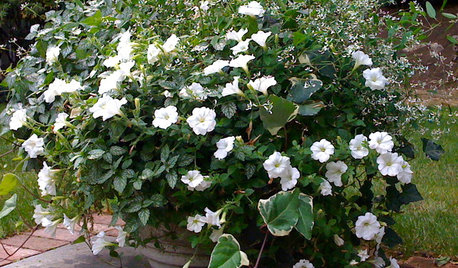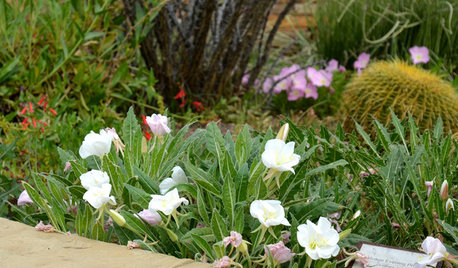Moonflowers
sammy zone 7 Tulsa
11 years ago
Related Stories

GARDENING GUIDES11 Perfect Plants for a Moonlit Garden — in Pots
Create an alluring after-dark aura on a patio or deck with container plants that glow white under the stars
Full Story
LANDSCAPE DESIGNAll-White Gardens Light Up the Night
Lustrous blooms in white, cream and the palest ivory enchant in the landscape at night — and can be practical too
Full Story
FALL GARDENINGReflecting on a Gardening Year
Mistakes and successes, surprises and comforts. The garden helps us grow in new ways every year
Full Story
MOST POPULAR20 Ways to Work White Magic in Your Yard
Create enchanting outdoor spots with fresh white fences, florals and furniture
Full Story
FALL GARDENINGBe Your Own Wildflower Nursery
Gather seeds from your garden in fall, and you'll have a selection of plants for next year — without spending a dime
Full Story
GARDENING GUIDES8 Plants for a Deliciously Fragrant Fall Garden
Scent the autumn air with the perfume of caramel corn, honey and spices by adding these intoxicating plants to your landscape
Full Story
FLOWERS AND PLANTSTufted Evening Primrose Shines at Night
Oenothera caespitosa waits until the sun is ready to set before unfurling its large white petals that draw visitors and evening pollinators
Full Story
GARDENING GUIDESTexas Gardener's June Checklist
Win the battle against heat and drought with these plant picks and extra effort, for a garden that reigns supreme in summer
Full Story
GARDENING AND LANDSCAPINGPorch Life: 12 Ways to Beautify a Porch With Plants
Abundantly welcoming, plants rooted in pots, hanging in baskets or climbing up a trellis add life to porches
Full Story
LANDSCAPE DESIGNMake Your Roses Even More Beautiful With These Companion Plants
Nourish your rosebushes and create a visual feast with these 7 classic and unexpected plant pairings
Full StorySponsored
Zanesville's Most Skilled & Knowledgeable Home Improvement Specialists
More Discussions






helenh
Okiedawn OK Zone 7
Related Professionals
Carlisle Landscape Architects & Landscape Designers · Derry Landscape Architects & Landscape Designers · Ballwin Landscape Architects & Landscape Designers · Graham Landscape Architects & Landscape Designers · Mooresville Landscape Contractors · Ashburn Landscape Contractors · Dickinson Landscape Contractors · East Chicago Landscape Contractors · Forest Hills Landscape Contractors · McLean Landscape Contractors · Royal Oak Landscape Contractors · Suitland Landscape Contractors · Sun City Center Landscape Contractors · Benton Decks, Patios & Outdoor Enclosures · Brentwood Decks, Patios & Outdoor Enclosuressammy zone 7 TulsaOriginal Author
Lisa_H OK
scottokla
seeker1122
Okiedawn OK Zone 7
Lisa_H OK
susanlynne48